Roofing Companies Great Sankey
Find Roofing Company in Great Sankey
Get up to 3 Roofing Companies quotes for your project today! Compare profiles, reviews, accreditations, portfolio, etc... and choose the best offer.
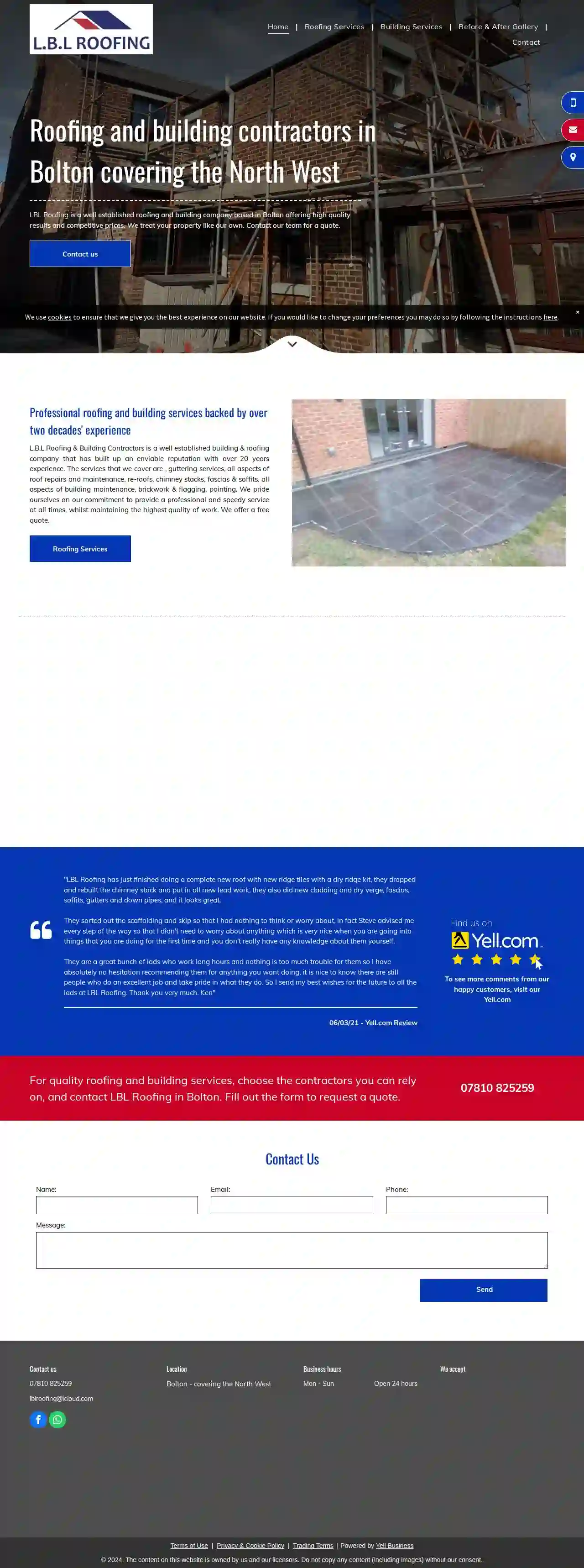
LBL Roofing & Building
4.838 reviewsBolton, GBLBL Roofing is a well established roofing and building company based in Bolton offering high quality results and competitive prices. We treat your property like our own. We have over 20 years experience and cover all aspects of roofing, guttering services, all aspects of roof repairs and maintenance, re-roofs, chimney stacks, fascias & soffits, all aspects of building maintenance, brickwork & flagging, pointing. We pride ourselves on our commitment to provide a professional and speedy service at all times, whilst maintaining the highest quality of work. We offer a free quote.
- Services
- Why Us?
- Our Team
- Testimonials
- Gallery
Get Quote
Paul Jones Roofing Systems - Roofer Wigan
4.513 reviews38 Knowles Place, Wigan, WN1 3LB, GBPaul Jones Roofing Systems is a highly recommended roofing company based in Wigan, Lancashire. With years of experience, we've built an enviable reputation for our honest, hard-working approach and commitment to delivering top-quality roofing services. We specialize in a wide range of roofing solutions, including slate roofing, felt roofs, fascias, soffits, and guttering. Our team of fully qualified and safety-tested experts provides professional advice and expert workmanship, ensuring your project is completed to the highest standard. We understand that your home is your sanctuary, and we strive to make your roofing experience as smooth and stress-free as possible. We are dedicated to providing exceptional customer service and exceeding your expectations. We are proud to offer a unique roofing service throughout Wigan, helping you bring your dream home closer to reality. Our track record for punctuality and courtesy is unmatched. We keep our promises and deliver every project on time. Why choose Paul Jones Roofing Systems? * **Reputation:** We've earned an excellent reputation in our local area for being a professional and expert roofing company. Most of our work comes from word-of-mouth recommendations from satisfied clients. * **Work Ethic and Ethos:** We believe your home plays a vital role in your well-being. A house that feels like a home makes a significant difference to your happiness, and we aim to contribute to that feeling. Contact us today for a free consultation on 01942 466440 or send us a message through our contact page. We're happy to answer any questions you may have about our company or your project.
- Services
- Why Us?
- Our Team
- Testimonials
- Gallery
Get Quote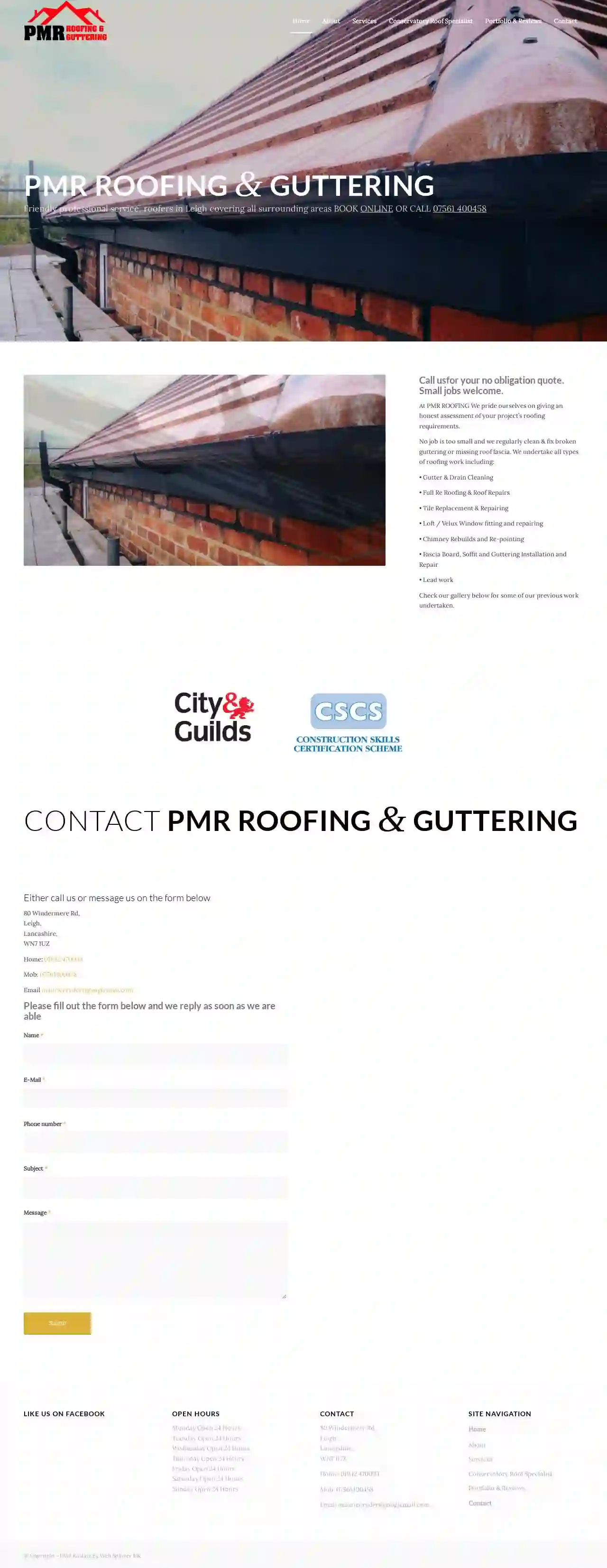
P M R Roofing & Guttering
4.453 reviews80 Windermere Rd, Leigh, WN7 1UZ, GBPMR ROOFING & GUTTERING is a friendly and professional roofing service based in Leigh, covering all surrounding areas. We pride ourselves on providing honest assessments of your roofing needs, no matter how big or small. We're happy to take on everything from small repairs like cleaning and fixing gutters to larger projects like full re-roofing. Our services include: Gutter & Drain Cleaning Full Re Roofing & Roof Repairs Tile Replacement & Repairing Loft / Velux Window fitting and repairing Chimney Rebuilds and Re-pointing Fascia Board, Soffit and Guttering Installation and Repair Lead work You can view examples of our previous work in our gallery. To get a free, no-obligation quote, simply call us or fill out the contact form below. Contact PMR ROOFING & GUTTERING 80 Windermere Rd, Leigh, Lancashire, WN7 1UZ Home: 01942 470093 Mob: 07561400458 Email: [email protected]
- Services
- Why Us?
- Our Team
- Gallery
Get Quote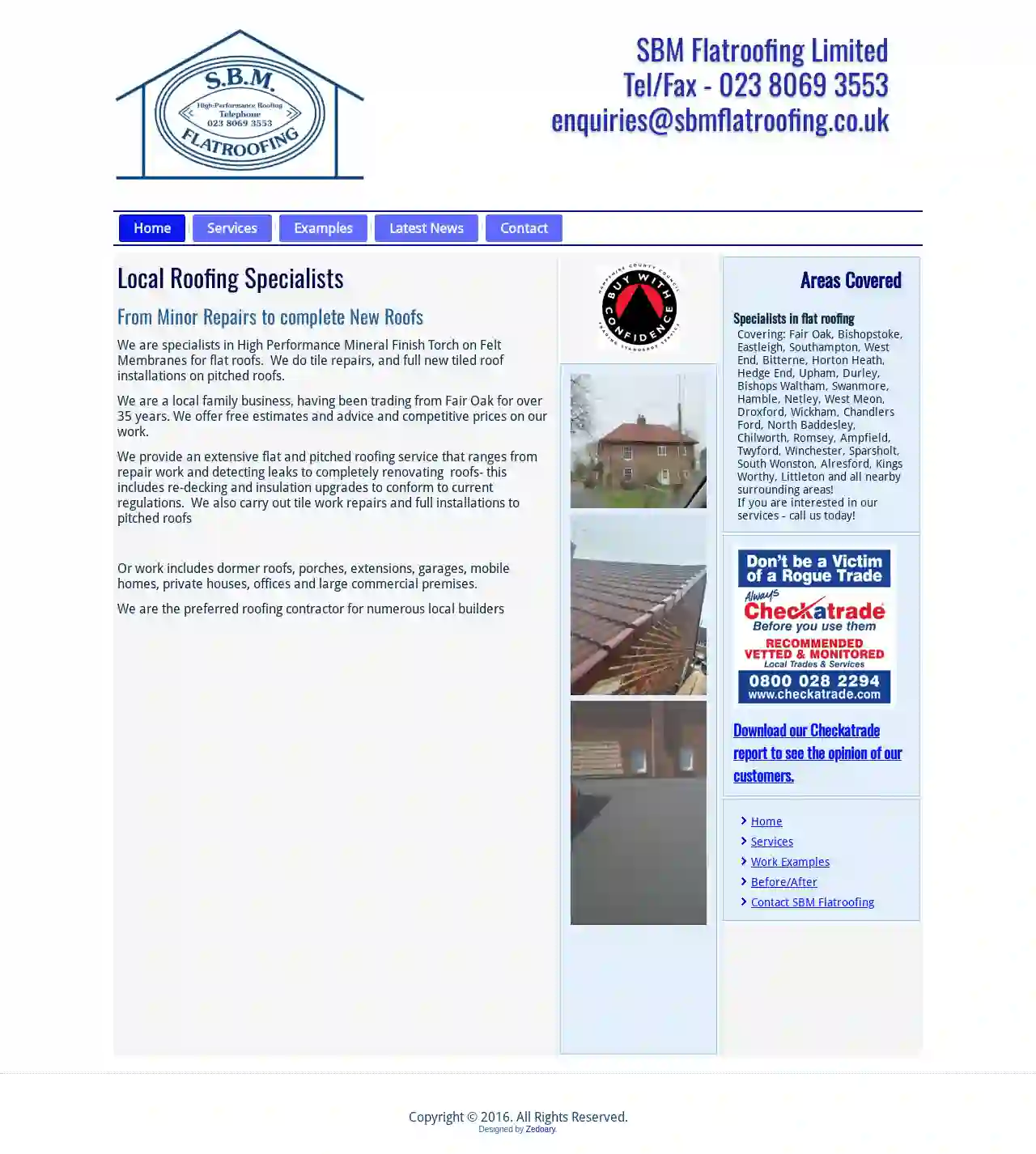
SBM Flat Roofing Ltd
54 reviewsLeigh, GBSBM Flatroofing Limited is a local family business with over 35 years of experience in flat and pitched roofing. We specialize in high-performance mineral finish torch-on felt membranes for flat roofs and offer a range of services from minor repairs to complete new roofs. We provide free estimates and advice, and our prices are competitive. Our services include repair work, detecting leaks, and renovating roofs, as well as tile work repairs and full installations on pitched roofs. We cover a wide range of areas, including Fair Oak, Bishopstoke, Eastleigh, Southampton, and many more. If you're interested in our services, call us today!
- Services
- Why Us?
- Gallery
Get Quote
TRS Roofing & Plastics ltd
5110 reviewsTRS Unit, Chapel Street, Pemberton, Wigan, WN5 8JR, GBTRS Roofing & Plastics is a true family-run business with over 20 years experience. TRS Roofing & Plastics stands out as the premier choice for all your roofing needs. As experienced roofers in Wigan, we have built a solid reputation for reliability and excellence. Our priority is delivering top-quality workmanship, ensuring every project is completed with precision and expertise. Our team of skilled professionals is dedicated to providing exceptional service, utilizing the latest techniques and premium materials. Furthermore, we are committed to customer satisfaction, offering personalized solutions tailored to meet your specific requirements. Choose TRS Roofing & Plastics for trusted roofers in Wigan who deliver outstanding results every time.
- Services
- Why Us?
- Our Team
- Gallery
Get Quote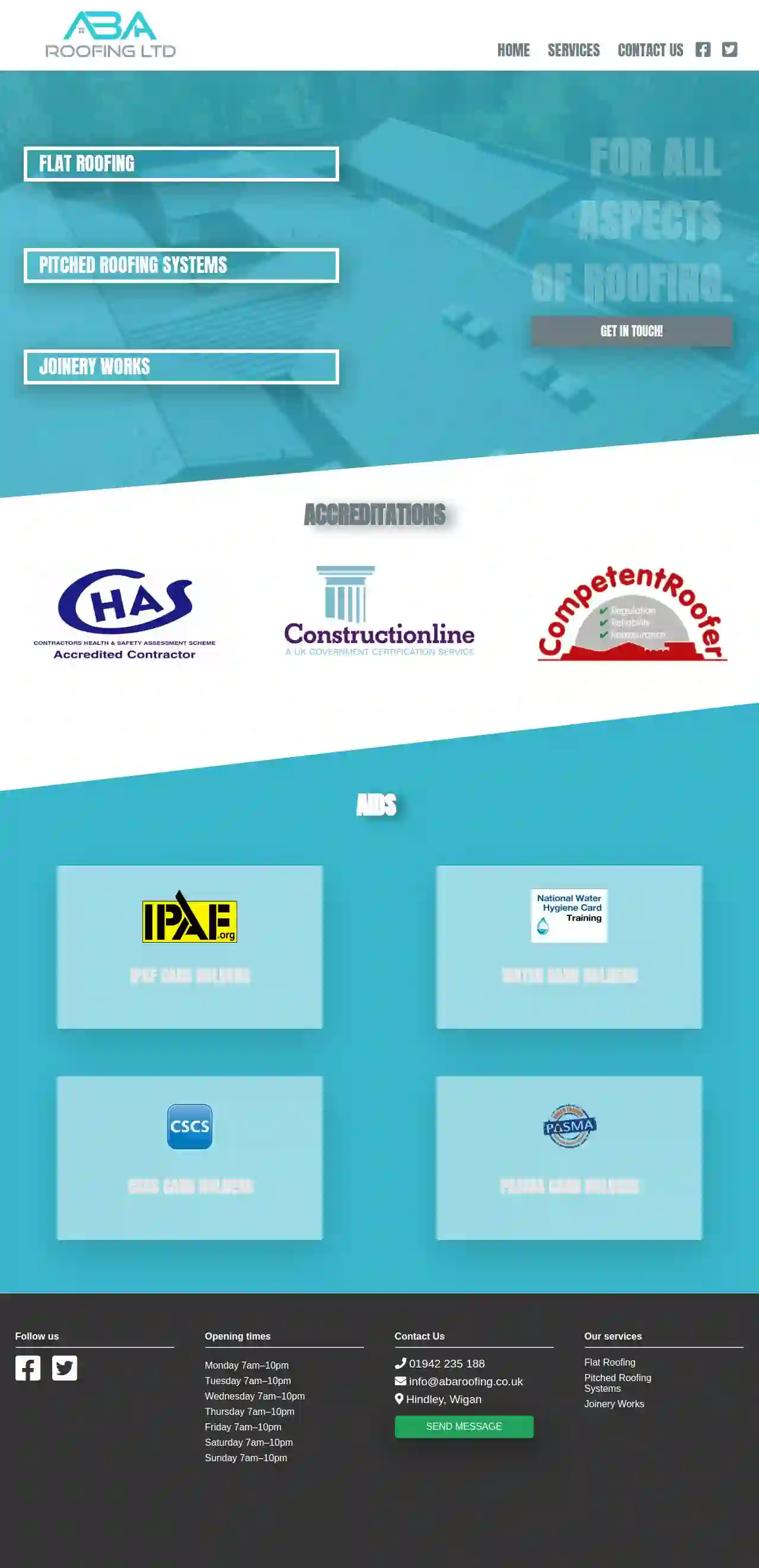
A.B.A ROOFING (Wigan)
54 reviews123 Main Street, Brighton, BN1 1AA, GBA.B. Roofing is a family-run business with over 25 years of experience in the roofing industry. We pride ourselves on providing high-quality workmanship and excellent customer service. We offer a wide range of roofing services, including new roof installations, roof repairs, and roof maintenance. We are fully insured and accredited, and we are committed to providing our customers with the best possible service. Our team of experienced roofers is dedicated to providing our customers with the highest quality workmanship. We use only the best materials and equipment, and we are always up-to-date on the latest roofing techniques. We are committed to providing our customers with a stress-free roofing experience. We offer a free no obligation quote on all of our services. Contact us today to learn more about our services or to schedule a free consultation.
- Services
- Why Us?
- Accreditations
- Our Team
- Testimonials
Get Quote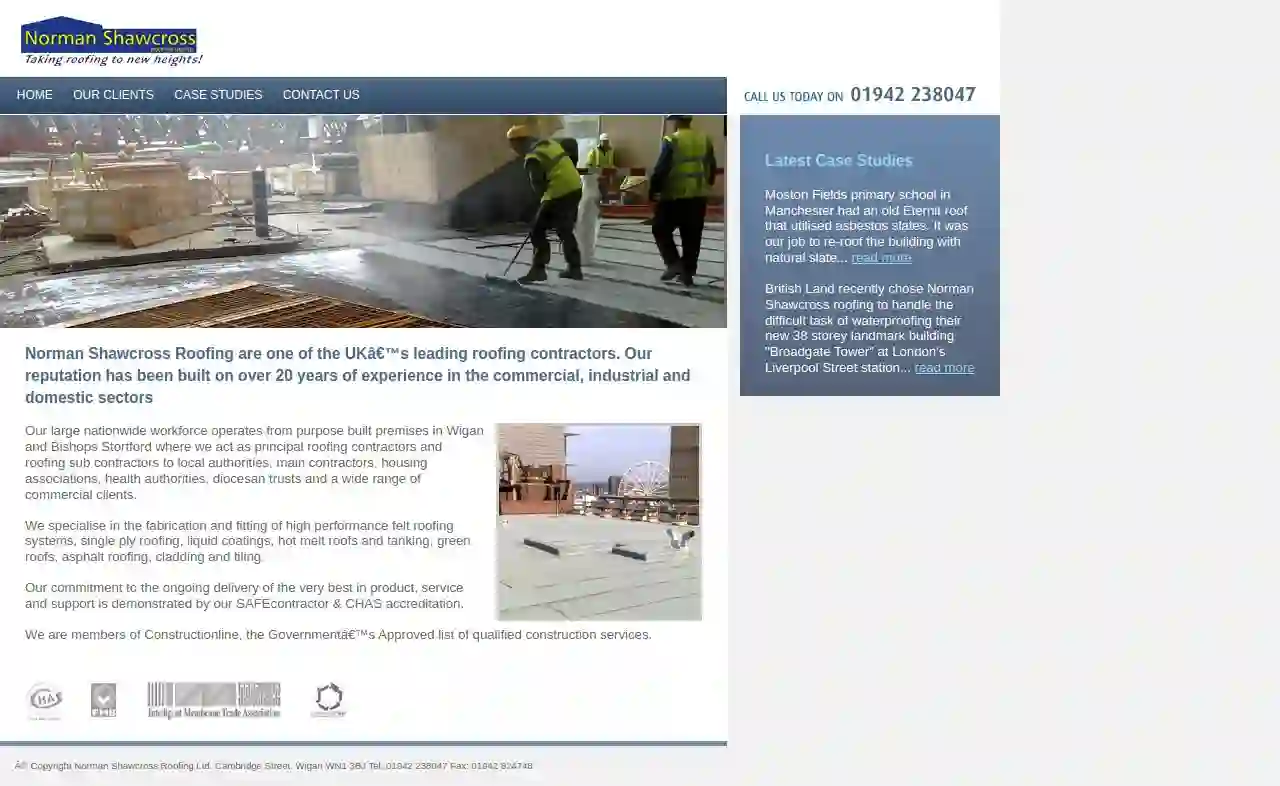
Norman Shawcross Roofing Ltd
32 reviewsCambridge Street, Wigan, WN1 3BJ, GBNorman Shawcross Roofing are one of the UK’s leading roofing contractors. Our reputation has been built on over 20 years of experience in the commercial, industrial and domestic sectors. Our large nationwide workforce operates from purpose built premises in Wigan and Bishops Stortford where we act as principal roofing contractors and roofing sub contractors to local authorities, main contractors, housing associations, health authorities, diocesan trusts and a wide range of commercial clients. We specialise in the fabrication and fitting of high performance felt roofing systems, single ply roofing, liquid coatings, hot melt roofs and tanking, green roofs, asphalt roofing, cladding and tiling. Our commitment to the ongoing delivery of the very best in product, service and support is demonstrated by our SAFEcontractor & CHAS accreditation. We are members of Constructionline, the Government’s Approved list of qualified construction services.
- Services
- Why Us?
- Accreditations
- Gallery
Get Quote
Alpha Roofing Systems Ltd
52 reviewsUnit C3(2) Centre Court, Walter Leigh Way, Moss Industrial Estate, Leigh, WN7 3PT, GBAlpha Roofing Systems is a leading provider of commercial and industrial roofing solutions in the North West of England. With over 50 years of combined experience, we offer a comprehensive range of services, including flat roofing, sheeting and cladding, principal contractor services, repairs and maintenance, and lightweight roofing tiles. We pride ourselves on delivering exceptional results, consistently exceeding customer expectations. Our commitment to quality is reflected in our use of the very best materials and processes, ensuring that every project is completed to the highest standards. At Alpha Roofing Systems, we understand the importance of a safe and efficient working environment. We adhere to all relevant health and safety legislation and building/planning guidelines, ensuring that our projects are carried out with minimal disruption to your business. Our team of experienced professionals is dedicated to providing a truly personalized service. We work closely with our clients throughout the entire project lifecycle, from initial consultation to final completion, ensuring that their needs are met every step of the way. Whether you require a new roof installation, repairs to an existing roof, or a complete refurbishment, Alpha Roofing Systems is the trusted partner for all your roofing needs.
- Services
- Why Us?
- Accreditations
- Our Team
- Testimonials
- Gallery
Get Quote
Waderose Roofing
94 Almond Brook Road, Wigan, WN60ST, GBWaderose Roofing is a family-run business based in Wigan, Lancashire, serving the surrounding areas. We pride ourselves on providing high-quality roofing services with many years of experience in the field. Our commitment to customer satisfaction is evident in our work, which is built on honesty, hard work, and a dedication to exceeding expectations. We offer a wide range of services, from small repairs to large-scale projects, ensuring we can meet all your roofing needs. Whether you require rubber roofs, slate roofing, Velux windows, pointing and chimney work, or any other roofing service, our team of experts is here to help. We strive to make the process as smooth as possible, starting with a free, no-obligation quote and clear communication throughout the project.
- Services
- Why Us?
- Our Team
- Testimonials
- Gallery
Get Quote
Castle Roofing Northwich
3.813 reviewsNorthwich, GBCastle Roofing Northwich, has been established since 1998, we are an independent, family-run business. Our team of roofing experts specialises in new roof installations, roof repair as well as offering all types of general building work. Whether you are looking for a small, simple repair, or you require a complete new roof installation, Castle Roofing Northwich are the local contractors you can trust.
- Services
- Why Us?
- Gallery
Get Quote
Over 12,314+ Roofers in our network
Our roofing contractors operate in Great Sankey and beyond!
Roofyng.co.uk has curated and vetted Top Roofers in and around Great Sankey. Find the most trustworthy pro today.
Frequently Asked Questions About Roofing Companies
- Asphalt Shingles: 20-30 years
- Metal Roofing: 40-70 years
- Tile Roofing: 50-100 years or more (clay and slate)
- Flat Roofing: 15-30 years (depending on material)
- Slate: 100 years or more
- Wood Shakes or Shingles: 30-50 years (with proper maintenance)
- Leaks or Water Stains: Water stains on ceilings or walls, dripping water, or dampness in the attic.
- Missing, Cracked, or Curled Shingles: Inspect for damaged or missing shingles, especially after a storm.
- Damaged Flashing: Look for rust, corrosion, or gaps in flashing around chimneys, vents, or skylights.
- Sagging or Uneven Rooflines: A sagging roof could indicate structural problems.
- Granule Loss: Excessive granules in gutters suggest aging asphalt shingles.
- Moss or Algae Growth: Can trap moisture and damage roofing materials.
- Metal roofs: Reflect sunlight, reducing cooling costs.
- Tile roofs: Offer thermal mass, regulating temperature.
- Cool roofs: White or light-colored roofs with high solar reflectance.
- Green roofs: Vegetated roofs providing insulation and reducing heat absorption.
How long does a roof typically last?
What are some common signs of roof damage?
What is fascia, and why is it important?
What are some energy-efficient roofing options?
How long does a roof typically last?
- Asphalt Shingles: 20-30 years
- Metal Roofing: 40-70 years
- Tile Roofing: 50-100 years or more (clay and slate)
- Flat Roofing: 15-30 years (depending on material)
- Slate: 100 years or more
- Wood Shakes or Shingles: 30-50 years (with proper maintenance)
What are some common signs of roof damage?
- Leaks or Water Stains: Water stains on ceilings or walls, dripping water, or dampness in the attic.
- Missing, Cracked, or Curled Shingles: Inspect for damaged or missing shingles, especially after a storm.
- Damaged Flashing: Look for rust, corrosion, or gaps in flashing around chimneys, vents, or skylights.
- Sagging or Uneven Rooflines: A sagging roof could indicate structural problems.
- Granule Loss: Excessive granules in gutters suggest aging asphalt shingles.
- Moss or Algae Growth: Can trap moisture and damage roofing materials.
What is fascia, and why is it important?
What are some energy-efficient roofing options?
- Metal roofs: Reflect sunlight, reducing cooling costs.
- Tile roofs: Offer thermal mass, regulating temperature.
- Cool roofs: White or light-colored roofs with high solar reflectance.
- Green roofs: Vegetated roofs providing insulation and reducing heat absorption.